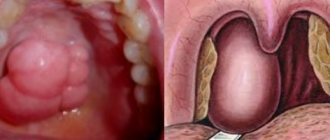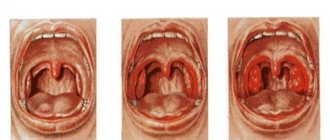A feeling of choking in the throat is not a typical symptom of a classic ARVI, but a manifestation of a long list of other diseases from neurosis to oncology.
It would be incorrect to say that such a condition has an exclusively infectious-inflammatory etiology. This is wrong.
In most cases, the feeling of lack of air is not of viral or bacterial origin (although this sometimes occurs).
The symptom is dangerous due to the probable increasing obstruction (narrowing) of the airways and, as a result, the formation of asphyxia, when air cannot move normally through the anatomical structures.
This can be fatal. That is why it is so important to promptly identify the corresponding disease or correct the main symptoms.
Reasons for the development of the problem
Choking in the throat is a typical symptom of many diseases, as well as conditions that are not pathologies in themselves.
Interesting:
A distinctive feature of this sensation is its false localization: the patient feels suffocation in the neck and throat, believing that the source of the problem is located here, but in 70% of cases this is not the case.
It is important to note that ENT diseases are always accompanied by characteristic signs: fever, cough, pain, and are usually visible visually: red back wall, swollen tonsils, white spots, dots, plaque, etc.
If breathing difficulties are not accompanied by additional symptoms, but occur periodically and paroxysmally, we are talking more about neurosis or allergies.
In cases where breathing stops on a regular basis, pulmonary, endocrine, cardiac and tumor diseases are primarily suspected.
All the reasons for the development of a dangerous manifestation can be presented as follows:
- Bronchial asthma.
- Hyperventilation (hyperventilation syndrome).
- Chronic obstructive pulmonary disease (COPD for short).
- Traumatic damage to the throat and/or larynx.
- Pneumothorax.
- Heart attacks of various origins.
- Panic attack.
- Pneumonia.
- Allergic reaction of varying degrees of intensity, including anaphylactic shock.
- Lung cancer.
- Neoplasms in the laryngopharynx.
- Swelling of the throat.
- Diphtheria.
- Angina.
- Pharyngitis.
- Diseases of the thyroid gland in an advanced stage.
- Neuroses.
Each pathology requires a special approach to treatment and is characterized by additional symptoms.
Let's look at them all in order.
Inflammatory processes in the throat area
Inflammation of the tissues of the larynx causes swelling of the mucous membrane and the feeling of a foreign object inside the esophagus or trachea. The cause of inflammatory processes is viral and bacterial lesions of soft tissues.
The infection penetrates the mucous membrane and causes an inflammatory process. Swelling and a feeling of suffocation will be a consequence of laryngitis, pharyngitis and infectious lesions. The inflammation process occurs acutely or chronically.
Infections causing inflammatory processes:
- ARVI.
- Flu.
- Tonsillitis.
- Follicular tonsillitis, developing into paratonsillitis or tonsil abscess.
- Diphtheria.
- Other bacterial infections.
Osteochondrosis
If there is pressure in the throat and neck pain, the cause may be osteochondrosis of the cervical spine, injury or intervertebral hernia. Compression of the roots between the vertebrae and abnormal development of the spinal column often cause discomfort in the neck, throat and shoulder girdle. The pathology has a spectrum of symptoms, ranging from a feeling of tightness to numbness.
With an allergic reaction, asphyxia often occurs as a result of swelling of the mucous membrane of the throat. In severe cases, it can develop into false croup, Quincke's edema and complete blockage of the airways. Taking medications, getting allergens through the air or in food often causes such sensations. The most dangerous is considered to be swelling of the throat or false croup.
Swelling of the throat develops gradually or quickly, with the appearance of a slight soreness. This later turns into a feeling of discomfort, with a feeling of a foreign object in the esophagus. After some time, pain may appear when speaking and heaviness when swallowing liquid food, up to complete asphyxia.
IMPORTANT: When the cause of the development of edema is known, you need to quickly apply the treatment prescribed by your doctor.
Reflux
The reflux of digestive juices and eaten food from the stomach causes a permanent burn of the mucous membrane of the esophagus. The result is discomfort and unpleasant sensations. Subsequently, an ulcer of the esophagus, neoplasms, and infection may develop.
Psychogenic factors
Some neurological diseases can cause reflex discomfort in the neck and throat. Neurologists and psychiatrists identify several specific diseases that cause similar symptoms without physiological disturbances in the organs and tissues of the throat:
- depression,
- neurasthenia,
- fright,
- hyperventilation syndrome,
- periodic panic attacks.
It has been observed that women are more likely than men to suffer from such problems. In neurological diseases, the feeling of suffocation is complemented by:
- cardiopalmus,
- dizziness,
- loss of consciousness,
- numbness of the limbs.
At first, attacks are rare, but over time they occur more often with the addition of new symptoms.
In medical practice, there are people who are susceptible to suggestion and self-hypnosis. They attribute new diseases to themselves and firmly believe in their existence. First of all, it is necessary to determine the presence of somatic or neurological diseases and carry out appropriate treatment.
Some diseases of the digestive system can cause discomfort in the throat area. These include inflammation of the gastric mucosa, ulcers and gastritis.
As a rule, with gastroenterological diseases, this symptom, together with others, appears after eating.
Once the mucosa is damaged, scarring, swelling, or perforation of the soft tissue may occur.
Damage is divided into:
- physical – swallowing hard objects, bruise or fish bone in the throat,
- chemical - consumption of concentrated acids or alkalis in food, accidental inhalation of caustic aerosols,
- thermal - eating hot or cold food.
Depending on the degree of damage, the method of exposure and the body's reaction, swelling occurs suddenly or gradually. A feeling of suffocation in the throat occurs with direct impact on soft tissue or subsequently.
The most dangerous can be considered damage to the thyroid gland and through perforation of the throat. Constant compression (wearing constrictive clothing on the neck) can also cause a feeling of suffocation. If there was trauma or cases of compression of the larynx in the past, then today's problem may be their consequence.
IMPORTANT: Young children are most at risk of injury due to their constant desire to put things in their mouths.
Chronic obstructive pulmonary disease
COPD is a common cause of a feeling of choking in the throat. The essence of the pathological process is the development of intense obstruction of the alveoli and bronchial tree.
Reasons for the formation of the disease:
- Smoking. It has a negative effect on the lungs and bronchi.
- Work at cement plants, chemical industrial facilities.
- Genetic predisposition.
Prematurity in childhood, active and passive smoking, and dietary levels low in vitamins play a major role in the development of the problem.
Characteristic symptoms:
- Destruction of the lung parenchyma, as seen on x-rays and tomography.
- Separation of a large amount of sputum during the cough reflex.
- Increased blood pressure (hypertension).
- Formation of the so-called pulmonary heart (enlargement of its right parts as a result of lung pathology).
- Hyperventilation syndrome.
- Intense cough.
- Shortness of breath and suffocation.
There is no specific treatment. Therapy is carried out with corticosteroids and bronchodilators.
Causes
Spasm of the larynx followed by suffocation may be the cause of an inadequate reaction of the body to any irritants. In some cases, the sudden onset of shortness of breath indicates the development of pathologies of internal organs and systems.
Bronchial asthma
The feeling of suffocation and lack of air most often occurs against the background of bronchial asthma. The pathology is chronic and can also be aggravated by allergic or infectious manifestations.
The bronchi, subject to a pathological process, undergo irreversible changes over time, which causes the airways themselves to become deformed. Bronchial asthma is characterized by a stable symptom complex: severe shortness of breath against the background of heavy breathing with whistling. Attacks often occur at night or early in the morning.
Chronic airway obstruction syndrome
Chronic upper respiratory tract obstruction syndrome is characterized by the systematic occurrence of signs of suffocation. Often, such an unfavorable state of the body occurs against the background of long-term smoking, working in hazardous industries, and an unhealthy lifestyle in general.
Obstruction syndrome is characterized by forced secretion of mucus, which in abnormally large quantities clogs the bronchial ducts. There is a deterioration in pulmonary gas exchange against the background of pulmonary hypertension and destruction of parenchymal formations.
Laryngeal edema
Laryngeal edema is not an independent disease. This is always a sign of a disease or the body’s reaction to an irritant. Attacks of severe choking in the throat due to swelling of the larynx can occur due to burns from chemicals or hot drinks.
Often the body reacts this way to inflammation and taking certain pharmacological products. Laryngeal edema can be observed in the following pathological conditions:
- Measles;
- Severe flu;
- Chondroperiochondritis;
- Severe renal failure;
- Problems with the cardiovascular system;
- Liver problems.
Hyperventilation
It is a neurocirculatory dystonia. It is one of its forms.
The essence of the pathological process lies in artificial neurotic control of breathing, during which the respiratory rhythm is disrupted and the patient begins to suffocate, experiencing suffocation and shortness of breath.
Excessive oxygen leads to abnormal blood counts. Migraines, dizziness, and changes in heart rate begin.
The condition is corrected with mild sedatives and psychotherapy.
Traumatic injury to the larynx or throat
Most often, children of preschool and early school age encounter this kind of problem.
Possible causes of injury:
- a blow to the throat, which can lead to the formation of a hematoma, bruise, fracture, or displacement of anatomical structures;
- ingestion of a foreign object. For example, toys, small construction parts, etc.
In adults, throat injuries most often occur during the consumption of hard foods. The “classic” foreign body was and remains a fish bone.
The treatment is minimally invasive. It is required to remove the pathogenic object from the throat. The injury itself is corrected conservatively or surgically, depending on the nature of the damage.
What is pathology?
The patient cannot take a breath during an attack, this is explained by a spasm in the throat and chest. There is a feeling of some kind of barrier in the throat that does not allow oxygen to enter the lungs. Choking at night is an attack in which a person feels a lack of oxygen and a fear of death arises. The pathology can be called asphyxia, which appears spontaneously due to some reasons, often this happens in those people suffering from respiratory diseases.
If a person had a pathology such as shortness of breath, then an attack of suffocation during sleep may be a consequence of this particular disease. Sleep is a state of the body characterized by complete calm, but the danger is that with a lack of oxygen, the body's cells may experience oxygen starvation, which is fraught with unpleasant consequences. An attack of suffocation develops suddenly.
The reason for the development of choking in the neck area is not necessarily the presence of a concomitant disease, it may simply be a situation in which some changes occur in the throat. A striking example would be a throat injury, an allergic reaction to an insect bite, a foreign object (which often happens in children), stress, etc. Those who have pathologies in the thyroid gland may experience suffocation at night and more.
The mechanism of development of the disease is that swelling occurs, it is an obstacle in the glottis, the lumen of the upper respiratory tract narrows due to muscle spasm of the pharynx and larynx. A noise is heard in the chest during inhalation.
Pneumothorax
It develops, as a rule, with open (penetrating) chest injuries. In all such cases, immediate medical attention is required.
Atmospheric air enters the pleural cavity and compresses (squeezes) the lungs, causing a feeling of suffocation. Blood circulation is disrupted at the local level.
The symptoms are very typical: attacks of suffocation, shortness of breath, pain in the chest, inability to inhale or exhale normally.
Treatment is carried out with the help of painkillers. It is important to seal the chest.
If it is impossible to restore lung function, resection of the damaged area (partial removal) is required.
Why does a spasm in the throat occur?
Those who have experienced a spasm in the throat know firsthand what kind of panic can take over at this moment.
After all, this condition can vary from discomfort when swallowing to an attack of real suffocation, depending on the reasons that caused it. When a spasm occurs, a narrowing occurs in the pharynx, and in some cases the patient can face death if he does not seek help in a timely manner. It is extremely important to identify the cause of the development of this symptom in order to prescribe the correct treatment, since there may be several pathologies that lead to it.
The development of such a condition may have the following prerequisites:
- situational etiology, when sudden muscle contractions in the throat area are caused by external factors;
- endogenous nature, when we are talking about internal factors in the form of concomitant ailments that the patient suffers from.
External reasons
- Contact with an allergenic source;
- Air containing substances that irritate the respiratory tract when inhaled;
- Hasty swallowing of food;
- The use of drugs among the side effects, which include spasmogenicity;
- State of stress;
- Severe pain syndrome;
- Physical and emotional overload.
Influence of internal factors
- With lesions of the thyroid/parathyroid glands (diseases of the endocrine system);
- For muscle spasms of the esophagus/pharynx in those who suffer from a hernia of the cervical vertebrae (diseases of the musculoskeletal system);
- In a state of hysteria (disorders of a psychoneurological nature);
- When the nerve endings of the muscles are irritated by neoplasms, the size of which is increased (oncological pathologies);
- In the presence of pharyngitis, laryngitis, acute tonsillitis (infection of the upper respiratory tract);
- due to the backflow of stomach juice into the esophagus during reflux disease (disease of the digestive tract);
- in a post-stroke state (vascular pathologies).
Heart attack
Defined as ischemic damage to the heart muscle. As a result of disruption of local blood circulation in the myocardium, destruction of surrounding tissue occurs, as a result of which the heart ceases to adequately pump blood throughout the body.
The condition is fraught with death. Death especially often occurs as a result of a large heart attack.
The reasons for the development of the condition are multiple. We are almost always talking about uncompensated hypertension and severe concomitant cardiac diseases.
The symptoms are atypical: pain develops behind the sternum of a dull pressing nature, shortness of breath, severe suffocation (as practice shows, it is localized precisely in the throat).
Therefore, if breathing problems occur, this may be a pre-infarction condition.
The patient feels a change in heart rhythm such as tachycardia (pulse more than 90 beats per minute). We can also talk about bradycardia (less than 60 beats per minute).
Treatment is carried out strictly in a hospital setting. Specialized medications are used to correct the condition, including anticoagulants, angioprotectors, and others.
Symptoms of pathology
Signs of laryngospasm can be seen with the naked eye, as muscle spasm is accompanied by pronounced symptoms. Symptoms of spasms in the larynx:
- inhalation becomes more difficult and difficult, the patient develops noticeable shortness of breath;
- sharp pain when swallowing;
- the neck muscles are in a tense state;
- cold sweat appears on the skin;
- sharp pain in the neck area;
- a lump appears in the larynx, which suffocates and does not allow saliva to be swallowed normally;
- the skin becomes bluish or pale.
If spasms in the throat appear due to exposure to external factors, they last several minutes and go away on their own, swallowing function is also restored. In the most severe and advanced cases, laryngeal spasm in adults can cause other symptoms. Among them are an intense cough, the appearance of convulsions or foam at the mouth, and pathologies of the cardiovascular system. Symptoms may vary slightly depending on the cause that triggered the breathing spasm. This can be severe heartburn, rhinitis, sneezing, pain and pain in the eyes, metabolic disorders. Symptoms of the disease can be very diverse, but in any case the pathology must be treated. Otherwise, it can lead to the most serious consequences - severe shortness of breath, suffocation and even death.
Panic attack
It is a variant of vegetative-vascular dystonia. By its nature it is an anxiety-neurotic disorder.
It is most typical for representatives of the fairer sex due to the characteristics of the nervous system.
As statistics and specialized studies clearly show, every fifth person has experienced a panic attack at least once in their life.
Most often, anxious and suspicious individuals with a weak, labile type of nervous system suffer, and the symptom arises as a result of its overstrain.
Treatment is carried out with mild sedatives. In severe cases, you cannot do without antidepressants (Fluoxetine, also known as Prozac, works especially well).
Choking manifests itself reflexively. The patient feels short of breath, may faint, and experiences an intense feeling of fear and panic. Suicide attempts are possible during an attack, especially if it is the first.
Pneumonia
Also called pneumonia. As the name suggests, the disease develops as a result of inflammation of the pulmonary parenchyma and bronchial tree.
Infectious damage to anatomical structures occurs.
Choking is felt just at the level of the throat, although this feeling is false.
There are only three reasons: a significant decrease in the activity of the immune system, the penetration of pathogenic structures (viruses, bacteria, fungi) into the body, the presence of trigger factors (hypothermia, taking cytostatics, other drugs, etc.).
The symptoms are very typical: pressing pain in the chest, problems with inhalation and exhalation, suffocation, shortness of breath, whistling when breathing, cardiac dysfunction, including tachycardia (accelerated heart rate), bradycardia (reverse process).
Causes of spasms and choking in the throat
The occurrence of spasms in the throat and choking
Often, spasms in the throat are situational in nature, that is, their appearance is triggered by the influence of certain external factors on the human body. In some cases, spasms in the throat are the body’s response to any irritation or injury of various types. A common phenomenon is the appearance of convulsive contractions of the muscles of the pharynx or larynx in combination with the progression of coma or pathology in the human body.
Some factors can be identified whose impact on a person can lead to the development of a response in the form of a throat spasm:
A fairly common occurrence is the development of throat spasms as a result of too large pieces of food or fish bones getting into it. The use of certain medications that are used to lubricate or irrigate the pharynx. Inhalation of polluted air, which contains large quantities of various irritants. Constant exposure to the human body of various allergens. Severe emotional stress or nervous stress. Severe fatigue, which resulted in increased physical stress.
Throat spasms are accompanied by difficulties in breathing and swallowing, but in some cases they can be neurogenic in nature.
The spasmodic state of the laryngeal muscles occurs as a result of severe irritation of certain groups of nerves localized in the larynx area.
It is worth paying attention to those patients who complain of periodic occurrence of attacks of throat spasm, since this may signal the development of acute myocardial infarction in the body.
Symptoms of the disease
Throat spasms are accompanied by the following symptoms:
The appearance of difficulty in breathing, which causes a slight noise. The neck muscles become tense, and this causes pain. The patient experiences problems with the process of swallowing food. There is a feeling of a lump in the throat. The skin becomes pale, and in the case of a prolonged spasmodic state, it turns blue. cold sweat appears.
If a mild spasm occurs, it goes away on its own in just a few minutes, and normal breathing and swallowing function are restored.
In case of severe spasmodic condition of the larynx, if timely medical care is not provided, additional symptoms may occur:
General convulsions Foaming from the mouth Sudden loss of consciousness
All this leads to disruption of the cardiovascular system and the result of this pathological condition of the throat can even be fatal.
Of course, the easiest way to identify the spasm of the pharynx that develops as a result of the penetration of external irritants into the body in the form of food, liquid, air or medicine.
However, if throat spasms occur as a result of the progression of any pathology in the human body, then an analysis of the symptoms that arise will allow us to identify the specific cause of this condition:
Sore throat, laryngitis and pharyngitis are accompanied by the appearance of painful sensations when swallowing food and a hoarse voice, but the most pronounced symptom is the appearance of pain and sore throat. In the event that a spasm of the throat is a response to exposure to any allergen, then you can observe the following signs of pathology: the appearance of a sore throat, a strong and prolonged cough, a runny nose (which is accompanied by the appearance of clear mucus from the nose), prolonged sneezing, severe pain in the eyes and lacrimation. In diseases that cause disruption of the gastrodigestive tract, additional symptoms appear such as: heartburn and a feeling of a lump in the throat. Spasms in the throat can occur with an enlarged thyroid gland, and most often this is observed with moderate and severe pathology. The appearance of frequently recurring Throat spasms, which are combined with difficulties in swallowing food, and also do not cause rapid weight loss, can signal such a dangerous disease as a tumor of the esophagus.
Allergy
Allergic reactions are among the leaders in the number of cases of sudden suffocation. The immune response can have varying intensity. From a minor rash to bronchospasm and anaphylactic shock.
Each case needs to be examined separately.
The causes of allergies are varied. This includes ingestion of allergenic food, inhalation of pathogenic structures, dust, chemical compounds in the form of dyes, air fresheners, detergents and washing powders (most often these factors provoke the symptom in question).
Manifestations: intense suffocation, especially with Quincke's edema and anaphylactic shock, also with an attack of allergic bronchial asthma, pain in the chest, a feeling as if something is itching in the throat.
Often, suffocation is accompanied by classic manifestations of the immune response, including itching and redness of the skin, lacrimation, and copious discharge of clear mucus from the nose.
Treatment: first-third generation antihistamines, non-steroidal anti-inflammatory drugs, corticosteroids, bronchodilators in the system.
Causes of suffocation
Various factors can lead to the development of this condition, including environmental influences. Spasm and a feeling of suffocation in the throat can be a response to traumatic, thermal and mechanical irritation. In some situations, such a symptom is a manifestation of diseases of internal organs and systems.
There are several causes of choking in the throat that contribute to the development of spasm of the muscles of the larynx and pharynx:
- External use of drugs used for the treatment of infectious and inflammatory diseases of the oropharynx.
- Entry of large pieces of food into the lumen of the larynx. Also, the cause of spasm can be too dry food.
- Inhalation of air containing large amounts of chemical and dust irritating particles.
- Exposure to stress and severe nervous tension.
- Contact with the mucous membrane of the oropharynx of various allergens.
The spasm may be of neurogenic origin, occurring due to irritation of certain groups of nerves located in the larynx. This condition may indicate the development of a serious pathology, so people suffering from a feeling of choking in the throat need medical help.
Lung cancer
It is defined as an oncological lesion of bronchopulmonary structures of an infiltrative nature with the likelihood of developing secondary foci of tissue degeneration (metastases).
Requires urgent treatment in the early stages, this is the only way to ensure a complete recovery.
Most often, the disease occurs in experienced smokers and workers of hazardous chemical and other industrial enterprises.
Symptoms: pressure in the middle of the sternum, the patient has difficulty breathing, there is a lump in the throat, and in advanced stages hemoptysis appears (separation of a small amount of blood at first, then significant pulmonary hemorrhage).
At the initial stage, there is only a constant dry cough or with a minimal amount of sputum.
Therapy: surgical. Additional radiation and chemotherapy are carried out.
Neoplasms of the throat and larynx
Neoplasia in the laryngopharynx almost always causes suffocation and shortness of breath, as they block the lumen of the respiratory tract (so-called occlusion occurs).
There are several types of tumors:
- Angiomas. Vascular tumors. They are not prone to growth, so they are removed in extreme cases.
- Benign.
- Lipomas. They're wen.
- Chordomas. Neoplasia of cartilage tissue.
- Lymphangiomas. Tumors of lymphoid tissue.
- Fibroids. Neoplasms from connective tissue.
- Polyps. A type of fibroids. Prone to malignancy (malignant degeneration)
There are only two types of malignant neoplasia:
- Carcinomas.
- Sarcomas (much more aggressive than the first type).
Treatment in all cases is surgical.
Diphtheria
An infectious disease of bacterial origin (in most clinical situations) with a classic course. It always begins acutely, with an increase in temperature to 38-39 degrees.
On the second or third day, a sore throat, headaches, and a cough with a small amount of sputum are observed.
By the end of the third day, the tonsils are covered with a white, loose coating, which can be easily removed mechanically.
A feeling of suffocation in the throat occurs only when the process moves lower down the trachea and affects the vocal cords, which swell for 1-3 days, in other cases it is rare.
Angina
It is also acute or chronic tonsillitis. The causes are always infectious. The main role in the development of pathology is played by decreased immunity.
Symptoms: sore throat, weakness, fever, excessive exudation, etc.
Upon visual examination, both or one tonsil is enlarged. It is their swelling that causes suffocation in the throat, since the lumen of the larynx narrows significantly.
The treatment is specific, anti-inflammatory and aimed at destroying bacteria or other pathogens.
Causes of tightness in the throat
Many diseases have in their list of symptoms a feeling of suffocation in the throat, often turning into severe pain. Depending on the location, intensity and accompanying symptoms, the cause of the problem can be determined. The following diseases cause discomfort in the throat and neck area:
- inflammatory processes in the throat area,
- osteochondrosis,
- allergic reaction,
- reflux,
- psychogenic factors,
- diseases of the digestive system,
- traumatic injuries,
- tumor formations,
- hiatal hernia,
- thyroid dysfunction,
- other reasons.
There are many diseases that cause a feeling of suffocation in the throat.
Treatment of the feeling of suffocation, in the presence of an underlying acute or chronic disease, should be carried out after consultation with an appropriate specialist. First, the main pathology is affected, and then the symptoms. Depending on the diagnosis and condition of the patient, therapy is selected individually.
Treatment of edema:
- The allergic reaction can be controlled with antihistamines (Diphenhydramine, Suprastin, Tavegil).
- Inflammatory processes are treated depending on the underlying disease plus anti-inflammatory drugs.
- For infections, antibiotics, antiseptics and antivirals are used.
- Neoplasms are eliminated by surgery or medication.
- If the cervical spine is affected, therapeutic and prophylactic gymnastics are used.
- Therapy for Graves' disease is carried out with iodine preparations and adherence to the prescribed diet.
- Neurological patients are prescribed sedatives, breathing exercises, meditation, yoga and herbal medicine.
IMPORTANT: As soon as swelling begins, you should urgently seek medical help. If the process is not stopped, the airways may become completely blocked in the future and death from suffocation may occur.
Pharyngitis
It is an inflammation of the mucous membrane of the posterior pharyngeal wall (in 75% of cases of viral etiology) and has a similar clinical picture to tonsillitis. Often both pathologies “neighbor” each other and occur simultaneously.
The disease is characterized by a dry hacking cough, a feeling of constriction and a lump in the larynx (swelling of the mucous membranes plays a role here, so the patient has difficulty breathing, although these are rare cases), acute pain in the throat and moderate hyperthermia (37-38.5 degrees).
An additional manifestation is observed - a change in voice timbre.
What diseases provoke asphyxia
Asphyxia is understood as a state of suffocation caused by a lack of oxygen and a critical increase in the content of carbon dioxide in tissues and blood . Oxygen starvation is accompanied by various pathological symptoms with a predominance of respiratory failure.
Signs of choking in the throat are:
- painful tension in the neck muscles;
- rapid breathing (tachypnea);
- bluish color of the skin (cyanosis);
- dysphagia;
- tachycardia;
- inspiratory shortness of breath.
The terminal stage occurs with cold sweat, foam at the mouth, convulsions, and is dangerous due to fainting, coma, respiratory and cardiac arrest, and even death is possible.
Spasm in the throat and choking may be caused by microbial-parasitic aggression . When local immune defense factors are imperfect, pathogenic microorganisms adhere to the mucous membrane of the respiratory tract, indicating an inflammatory process. The air flow is disrupted by the development of edema, the pressure of the inflammatory infiltrate, or the accumulation of pathological deposits.
A feeling of suffocation and a lump in the throat will be a common symptom in the clinical picture of laryngitis, pharyngitis, and acute tonsillitis. In these diseases, signs of oxygen starvation are combined with catarrhal symptoms (cough, sore throat, sore throat, hyperthermia) and general intoxication of the body .
Respiratory disorders describe the course of the following ENT pathologies:
- false croup;
- epiglottitis (inflammation of the epiglottis);
- throat candidiasis;
- swelling of the larynx;
- chronic obstructive syndrome;
- pneumonia and pulmonary edema.
Spasm of the laryngeal muscles can be caused by hypertrophy of the thyroid gland. As the focal formations increase in size, they cause “compression syndrome” of the neck structures: suffocation, change in voice timbre (hoarseness, nasal tone), impaired swallowing, sore throat, painful sensations.
For reference! Severe respiratory distress is observed with vegetative-vascular dystonia, exhaustion of the nervous system, and impaired psychological adaptation.
Attacks of choking in the throat (but not asthma) are associated with gastroenterological pathologies (for example, reflux esophagitis), nervous diseases (stroke, thoracic intervertebral hernia), oncology, vascular disorders, and the growth of benign tumors.
Exogenous causes
The appearance of a feeling of suffocation in the throat is associated with situational factors . Often, airway obstruction occurs when the integrity of the anatomical structures of the larynx is damaged by mechanical, chemical or thermal damage (burns, aspiration of a foreign object, trauma).
Other predisposing factors include:
- dustiness of the air;
- aggressive environmental conditions with high levels of chemical elements in the atmosphere;
- exposure to low temperatures (for example, drinking cold water);
- contact with an allergen;
- taking antispasmodic drugs, drug overdose;
- nicotine poisoning;
- invasive procedures.
Depending on the etiological factors, the state of suffocation can develop suddenly and be accompanied by severe signs of respiratory failure or increase gradually , which allows the body to adapt to oxygen starvation.
For reference! The risk of airway obstruction is associated with age-related anatomical characteristics. For example, children have poorly developed respiratory muscles and a narrow lumen of the larynx, which is why the likelihood of partial or complete obstruction is very high.
Thyroid diseases
A goiter is possible due to thyrotoxicosis (excessive secretion of the hormones thyroxine T_4 and triiodothyronine T_3. The enlarged thyroid gland compresses the throat and gradually begins to choke the patient.
However, the symptom of lack of air is characteristic only at the advanced stage, when the size of the affected organ has increased by 20-30%, and this is already visible to the naked eye.
Goiter develops due to excess iodine in food. Treatment consists of changing a low-iodine diet, which is prescribed by an endocrinologist.











